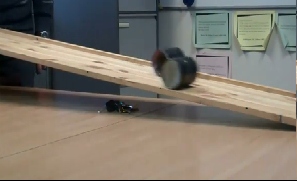1. Video
From Mechanics
(Difference between revisions)
m |
|||
| Line 23: | Line 23: | ||
|- | |- | ||
| [[Image:fig drum2.jpg]] | | [[Image:fig drum2.jpg]] | ||
| - | |valign="top"| | + | |valign="top"| If you are unable to do the drum experiment for yourself, try watching in on the link below. |
http://www.youtube.com/watch?v=O5vvSJjqTOU | http://www.youtube.com/watch?v=O5vvSJjqTOU | ||
| Line 45: | Line 45: | ||
http://www.youtube.com/watch?v=HGuIFPxuwrU | http://www.youtube.com/watch?v=HGuIFPxuwrU | ||
| - | |- | ||
| - | | [[Image:fig i.GIF]] | ||
| - | |valign="top"| In the first case the resultant force is upwards. As the parachutist is also moving downwards, he slows down. | ||
| - | |||
| - | In the second case the resultant force is zero and the parachutist moves with a constant speed. | ||
| - | |||
| - | |- | ||
| - | | [[Image:fig k.GIF]] | ||
| - | |valign="top"| The resultant force is always downwards. | ||
| - | |||
| - | If the resultant force were zero at the highest point, the ball would stay there!! | ||
| - | |||
| - | |- | ||
| - | | [[Image:fig m.GIF]] | ||
| - | |valign="top"| No, the motion is changing from downwards to upwards. | ||
| - | |||
| - | The resultant force is upwards, for almost all of the time that the ball is in contact with the table. | ||
| - | |||
| - | |- | ||
| - | | [[Image:fig n.GIF]] | ||
| - | |valign="top"| The direction of the motion is always changing, so the forces are not in equilibrium. | ||
| - | |- | ||
| - | | [[Image:fig p.GIF]] | ||
| - | |valign="top"| | ||
| - | |- | ||
| - | | [[Image:fig q.GIF]] | ||
| - | |valign="top"| [[Image:fig r.GIF]] | ||
| - | |- | ||
| - | | [[Image:fig s.GIF]] | ||
| - | |valign="top"| [[Image:fig t.GIF]] | ||
| - | |- | ||
| - | | [[Image:fig u.GIF]] | ||
| - | |valign="top"| [[Image:fig v.GIF]] | ||
|} | |} | ||
Revision as of 17:00, 9 April 2011
| Introduction | Video |



